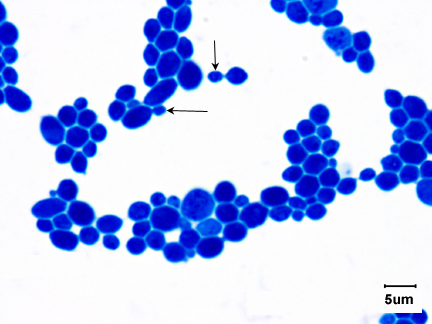10.1: Introduction
- Page ID
- 123395
Molds are multinucleated, filamentous fungi composed of hyphae. A hypha is a branching, tubular structure from 2-10 µm in diameter and is usually divided into cell-like units by crosswalls called septa. The total mass of hyphae is termed a mycelium. The portion of the mycelium that anchors the mold and absorbs nutrients is called the vegetative mycelium ; the portion that produces asexual reproductive spores is termed the aerial mycelium. (See Fig. \(\PageIndex{1}\).)
Molds possess a rigid polysaccharide cell wall composed mostly of chitin and, like all fungi, are eukaryotic (See Fig. \(\PageIndex{2}\).) Molds reproduce primarily by means of asexual reproductive spores such as conidiospores, sporangiospores, and arthrospores. These spores are disseminated by air, water, animals or objects and upon landing on a suitable environment, germinate and produce new hyphae. (See Fig. \(\PageIndex{1}\)). Molds may also reproduce by means of sexual spores such as ascospores and zygospores, but this is not common. The form and manner in which the spores are produced, along with the appearance of the hyphae and mycelium, provide the main criteria for identifying and classifying molds.
|
Fig \(\PageIndex{1}\): Asexual Reproduction in Molds |
Fig. \(\PageIndex{2}\): Segment of a Mold Hypha Showing Eukaryotic Nature |
|---|---|
 |
 |
| Copyright; Gary E. Kaiser, Ph.D. The Community College of Baltimore County, Catonsville Campus CC-BY-3.0 | |
Contributors and Attributions
Dr. Gary Kaiser (COMMUNITY COLLEGE OF BALTIMORE COUNTY, CATONSVILLE CAMPUS)

